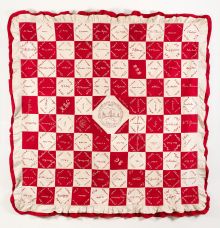'Sign Here!'
5th September - 13th December 2014
The Quilt Museum and Gallery in York will be showing its collection of historic Signature Quilts along with loans from other museums and private individuals from September to December this year.
Signature quilts (often called bazaar quilts) were a particular phenomenon of the 19th century. Often made to raise money for a church, chapel or charity, they were embroidered or signed either by, or on behalf of, the person contributing a sum for the privilege of having their name associated with the quilt. Similar quilts were sometimes made to commemorate an event such as an anniversary or as a memorial. This exhibition will explore some of the stories behind the making of these quilts.
“Tracing the provenance of quilts is a challenging pursuit and it is a joy to have these quilts in our collection with such a clear record of who, what, why and where. They are a great example of communities coming together to raise money for a common cause”, said Heather Audin, Museum Curator.
The Sheriff Hutton Bazaar Coverlet featured above is made from Turkey Red twill and white cotton squares. An image of Sheriff Hutton Castle is embroidered in red thread in the central square offering us details of “where”; the embroidered text ‘Sheriff Hutton Wesleyan Bazaar May 30 1898 Opened by J Coates Esq. C.C J.P.’ provides the “when” and every embroidered square containing initials or signatures gives us a record of “who”.
Signature Quilts provide clear markers for researchers and quilt historians who can trace surnames and events through census information, church records and local newspapers. This information greatly enhances our understanding of social history providing us with a snapshot from a local community at a particular point in time.
Signature quilts are still made by groups today, sometimes for similar reasons such as commemoration and raising money. They also provide inspiration for contemporary artists, such as Lynn Setterington who researches and uses historic signature quilts to inform her textiles and community engagement projects, and Sara Impey, who explores the power of words and their meaning in her contemporary work.
The Museum would like to thank the following Museums, institutions and individuals who have loaned items to the exhibitions: York Museums Trust, Leeds Museums Service, Beamish The Living Museum of the North, All Hallows Convent, British Quilt Study Group, Touchstones Rochdale Art Gallery, Link4Life Rochdale Boroughwide Cultural Trust, Englesea Brook Methodist Museum, Macclesfield SilkMuseums Trust, Brampton Methodist Church, Menwith Hill Quilters, Vivien Finch and Anne Jeater.
